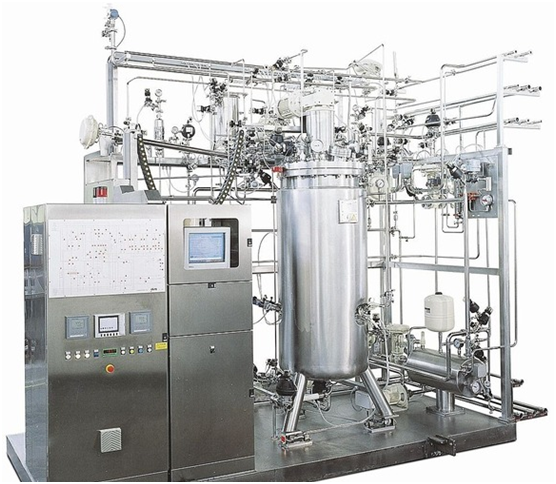Microbial metabolites are metabolic intermediate molecules synthesized by microorganisms during and after their growth. They are the metabolic intermediates of the biosynthetic and degradative pathways of microorganisms Microbes synthesize metabolites or metabolic intermediates at an increasing rate; and these metabolites are usually harvested or recovered by industrial processes usually at the end of the fermentation process. Microorganisms including bacteria, fungi, and actinomycetes are significant in fermentation processes because of the metabolites that they synthesize.
These organisms drive and activate fermentation processes, and the production of these intermediates help to drive their optimal growth and development for higher product yield. Microorganisms also help to breakdown large substrates or macromolecules to economically useful products through the processes of fermentation. There are basically two types of metabolites produced by microbes during and after their growth. These metabolites are primary metabolites and secondary metabolites.
PRIMARY METABOLITES
Primary metabolites are metabolic intermediates produced during the growth of an organism. They are produced during the exponential phase of growth of the organism. Primary metabolites are involved in the growth, development and reproduction of microorganisms. They are produced in microbes via the primary metabolic pathways that usually involve catabolic and anabolic reactions in which energy is generated and utilized respectively. Catabolic reactions (catabolism) are an energy-generating metabolism that generates the energy utilized in anabolic reactions (anabolism) for the biosynthesis of cellular components necessary for the growth, development and reproduction of the organism.
Typical examples of primary metabolic pathways include glycolysis/glycolytic pathway (metabolism of glucose to pyruvate), the pentose-phosphate pathway (for the provision of the reduced form of nicotinamide adenine dinucleotide, NADPH), and Entner-Doudoroff pathway (for generation of pyruvate in organisms that lack glycolytic pathway). Primary metabolites act as key components in maintaining the normal physiological and metabolic processes of the organism. Examples of primary metabolites produced by microbes during their exponential phase of growth include amino acids, organic acids, alcohols, enzymes, microbial cells (biomass), nucleotides and vitamins.
SECONDARY METABOLITES
Secondary metabolites are produced at the end of growth of the microorganism. They are produced during the stationary phase of growth (i.e. at the stage when the organism is resting and is not actively growing or multiplying). Secondary metabolites are not involved in the growth, development and reproduction of the organism. They are intermediate molecules that are produced through the modification of the primary metabolites. Secondary metabolites are produced through those metabolic pathways that are not used in the rapid growth of the organism. Some secondary metabolites provide defensive functions to the producer organisms and they also have tremendous economic importance. However, some other secondary metabolites confer no protection or have obvious value to the organism producing it.
The secondary metabolites produced by microbes are diverse in nature and these metabolic intermediates are species-specific end-products since the metabolites produced by a particular organism may differ from those produced by another organism. Examples of secondary metabolites produced by microbes include antibiotics, steroids, pigments, alkaloids, and toxins. Secondary metabolites play little or no significant roles in the physiological and metabolic processes of the organism producing them.
References
Bader F.G (1992). Evolution in fermentation facility design from antibiotics to recombinant proteins in Harnessing Biotechnology for the 21st century (eds. Ladisch, M.R. and Bose, A.) American Chemical Society, Washington DC. Pp. 228–231.
Nduka Okafor (2007). Modern industrial microbiology and biotechnology. First edition. Science Publishers, New Hampshire, USA.
Das H.K (2008). Textbook of Biotechnology. Third edition. Wiley-India ltd., New Delhi, India.
Latha C.D.S and Rao D.B (2007). Microbial Biotechnology. First edition. Discovery Publishing House (DPH), Darya Ganj, New Delhi, India.
Nester E.W, Anderson D.G, Roberts C.E and Nester M.T (2009). Microbiology: A Human Perspective. Sixth edition. McGraw-Hill Companies, Inc, New York, USA.
Steele D.B and Stowers M.D (1991). Techniques for the Selection of Industrially Important Microorganisms. Annual Review of Microbiology, 45:89-106.
Pelczar M.J Jr, Chan E.C.S, Krieg N.R (1993). Microbiology: Concepts and Applications. McGraw-Hill, USA.
Prescott L.M., Harley J.P and Klein D.A (2005). Microbiology. 6th ed. McGraw Hill Publishers, USA.
Steele D.B and Stowers M.D (1991). Techniques for the Selection of Industrially Important Microorganisms. Annual Review of Microbiology, 45:89-106.
Summers W.C (2000). History of microbiology. In Encyclopedia of microbiology, vol. 2, J. Lederberg, editor, 677–97. San Diego: Academic Press.
Talaro, Kathleen P (2005). Foundations in Microbiology. 5th edition. McGraw-Hill Companies Inc., New York, USA.
Thakur I.S (2010). Industrial Biotechnology: Problems and Remedies. First edition. I.K. International Pvt. Ltd. New Delhi, India.
Discover more from #1 Microbiology Resource Hub
Subscribe to get the latest posts to your email.



